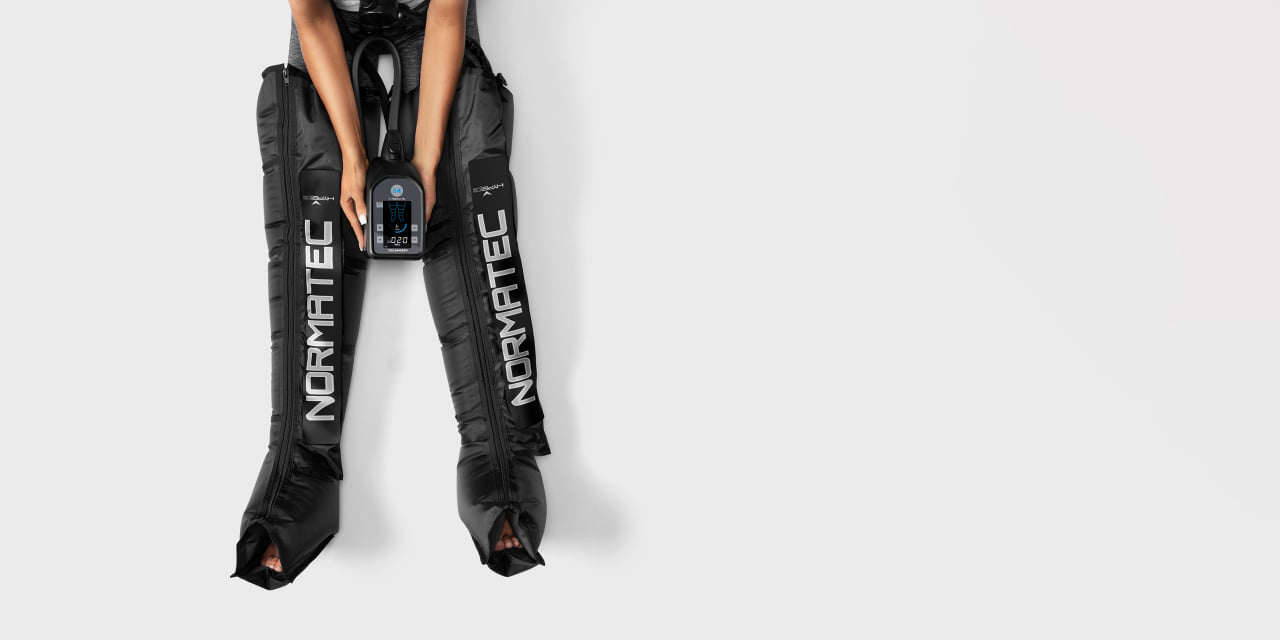The use of compression therapy generally falls into two categories.
The first is the professional range of boots and pneumatic compression boots, the most popular of which is Normatec.
Although this type of compression has been used in the ranks of professional athletes for many years, the high price tag made them impractical for most people not making a living with their bodies.
These days, their use has become a bit more widespread in the general fitness world, however, due to increased competition and big drops in price. Products that used to cost several thousand US dollars can now be had for between $500-$1000 USD.

Not inexpensive by any means, but closer to affordable for people that routinely spend hundreds (or thousands) of dollars on supplements, gym memberships, massages, personal training, and more.
The other category of compression gear is much less expensive and consists of compression garments. You can find compression gear for pretty much every part of the body, ranging from tights, to socks, shirts, arm sleeves, and more.
Though an entire medical-grade range of compression gear exists to treat specific medical conditions, most of the commercial gear marketed towards the fitness and performance market does not deliver the same level of compression.
Does compression therapy actually work?
Regardless of the type or category of compression therapy, the general mechanisms behind how it works are largely the same. Compression of the walls of your veins help them drive blood back to the heart and increase overall circulation.
Boots like Normatec use a pneumatic system to compress your legs in stages as you sit there and relax. Typical sessions range from 15-20 minutes.
Though there has not been an extensive amount of research done on this type of compression, there is enough evidence that they do, in fact, increase blood flow and circulation that can lead to reduced soreness and even increased range of motion.
It’s important to keep in mind, however, that much of this type of research is comparing the use of compression boots to a control group that does nothing to promote recovery.
Compared to being inactive, there is no doubt that driving circulation and blood flow with compression boots will likely have a benefit in recovery.

What is less well-documented, on the other hand, is whether or not the use of compression boots is any more or less effective than more active forms of recovery and regeneration like we’ve covered in previous lessons.
What about compression garments?
A good amount of research has tried to answer the question of whether or not wearing compression garments can actually improve performance and/or recovery, with mostly mixed results.
The majority of studies done in this area have focused on runners and endurance athletes to gauge whether or not wearing compression gear increases time to exhaustion and/or overall performance.
For the most part, little to no noticeable changes in this area have been seen in athletes wearing compression gear vs. those that are not. A large study funded by Nike showed no difference in fatigue after 30 minutes of treadmill running at 80% of max effort.
So performance… probably not.
For recovery, however, things are a bit more promising.
In this area, there is both evidence and anecdotal support that adding the right amount of compression post-workout can help aid in reducing soreness, reducing the buildup of metabolic waste products, and improving overall circulation.

The key here is that the right amount of compression is used. Too little has no real impact and too much may actually restrict blood flow.
The level of compression is measured in terms of millimeters of mercury. The level of compression supported in the research is 20-30 mmHg.
More than 30mmHg may be too much and less than 10mmHg is likely not enough.
This is why it’s important to do your homework before spending your money on compression gear. Many of the more popular brands do not post their level of compression.
When to wear compression gear
Although wearing compression gear during a high-intensity workout likely won’t improve performance or make you stronger, some people report feeling better with it on. There’s no real downside, and wearing it in the few hours afterwards may have a positive impact.
A particularly good use for high-quality compression gear is during and after a recovery workout. Here, the overall workout is at lower intensity and the major goal is to increase blood flow and overall circulation.
It makes sense that adding in a compression layer during and in the hours after this type of workout may enhance some of the benefits of this type of training.
Another good use of compression gear is if you have any level of chronic venous insufficiency (CVI), a condition where the vein walls and valves don’t effectively return blood back to the heart as well as they should.
This condition is more common than most people think, particularly in populations older than 40 years old. Common early signs include varicose veins in the legs and swelling of the ankles.
There are varying degrees of CVI, ranging from very mild to severe, and even the most mild cases can impact lower body performance and recovery. Research suggests up to 40% of the US population exhibits early signs, such as varicose veins, and somewhere between 2-5% likely have clinic level CVI.
Finally the use of compression socks and tights may be beneficial during long flights and times where you’ll be immobile. This is because they can help prevent the pooling of fluids while you’re seated for several hours or more and combat some of the physical effects of jet lag.
Taken as a whole, garments that offer between 20-30mmHg of compression are reasonably inexpensive, require no additional time or work to use, and likely provide some level of benefit.
This is particularly true when used during and after recovery workouts, when traveling, and/or if you have any degree of CVI that inhibits circulation throughout the legs to begin with.
Action Step
Some people report feeling a noticeable difference when wearing compression garments so if you’ve never tried them before, it can’t hurt to give them a shot for yourself. The easiest way to do this is by wearing a pair of high-quality compression socks.
The brand 2XU is one of the few top brands that allows you to search and sort by the compression level of their products. Less expensive can also be found on Amazon as well.
